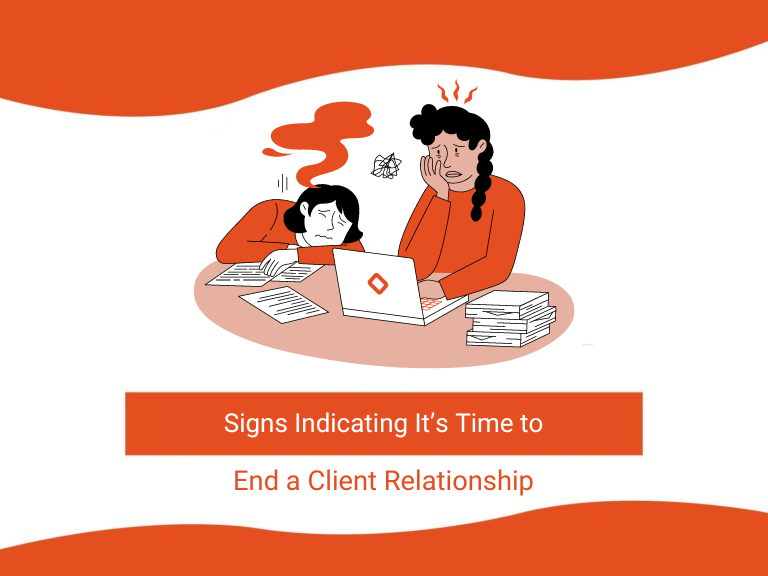Knowing When to Let Go – Signs Indicating It’s Time to End a Client Relationship
Maintaining a strong client base is essential in the field of customer service and commercial relationships. However, there are times when maintaining a customer relationship might be destructive rather than beneficial. Recognizing these indicators early on and knowing when it’s acceptable to discontinue a customer engagement graciously are essential components of maintaining development and protecting your company’s image and resources.
Here are five essential signs that may indicate that it is time to part ways with a client:
Excessive Time Consumption
Clients who regularly use more time than they offer value might have a negative influence on productivity. Unproductive meetings, continual objections without helpful criticism, recurrent delays in meeting deadlines, and poor reaction times are all red signals. Using time-tracking software might help in revealing clients who are consuming resources excessively.
Financial growth
Maintaining good customer connections is essential but they should also contribute to the financial stability of your organisation. If the resources and efforts put into serving a customer outweigh the returns and begin to cause financial pressure, it’s time to rethink the arrangement. Engaging in open and upfront talks about the value of the services offered may assist both parties align their opinions. However, if there is a continuous disagreement in how each party views the value exchange, splitting ways may be a reasonable option to maintain financial sustainability and long-term profitability.
Payment Issues
Consistent customer delays or non-payments harm the financial condition of any business. While occasional delays are normal under some circumstances, such as startup or transitional stages, recurrent payment concerns demonstrate a lack of appreciation for the services offered. Some specific tools might be useful in detecting clients with issue payment habits by tracking and managing invoices and exposing problematic payment patterns that require attention and resolution.
Shifting Expectations
Clients who frequently shift their expectations without providing clear direction could interfere with current initiatives. Continuous changes, abrupt adjustments in project goals, or unclear objectives tax resources and compromise output quality. Such challenges may be avoided by establishing clear and precise communication on project scopes and objectives from the start of the collaboration. Developing a thorough grasp of project needs and achieving mutual agreement can help to avoid misunderstandings and keep projects on schedule.
Disrespect for Your Team
In any professional situation, behavior that demeans or disrespects your team members is unacceptable. A work atmosphere polluted by constant negativity or employee undermining causes toxicity, which influences morale and productivity. Maintaining open lines of communication with your team helps you to identify and handle any disrespectful conduct as soon as possible. To maintain a healthy and productive work environment, it is critical to build a culture that appreciates and respects every team member and to address any issues that threaten this standard as soon as possible.
Businesses can maintain not just their financial stability but also a favorable and respectful work atmosphere, maintaining great client connections that contribute positively to their growth and success, by being attentive of these elements and quickly solving any emerging concerns.
Ending a customer relationship successfully requires professionalism and empathy. Here’s an overview of how to do it correctly.
- Examine Contracts: Ensure that the terms of the contract are followed when terminating the partnership. To prevent legal issues, exit the partnership at the end of the contract time.
- Finish Ongoing Projects: Maintain professionalism by completing ongoing projects, fulfilling agreed-upon deliverables, and ensuring a seamless transition without sacrificing quality.
- Plan and Communicate: Create a clear and thorough discussion plan. Practice explaining your decision’s rationale and, if possible, seek alternate recommendations.
- Be Direct While Maintaining Respect: Be direct while retaining respect while presenting the choice. Provide clarification on the problem and, if feasible, alternative recommendations.
Conclusion
Finally, determining when it is time to end a client contact is a necessary skill in customer service and commercial interactions. Companies should strategically redirect their efforts by actively spotting warning indications of an unproductive or unsuitable collaboration and then implementing separations with professionalism. Companies create the path for more meaningful, mutually beneficial interactions by recognizing when it’s time to gently quit unproductive ties. This conscious transformation allows them to form relationships based on mutual respect, common goals, and collaborative synergy, driving them to long-term success in the shifting environment of customer service and commercial partnerships.

